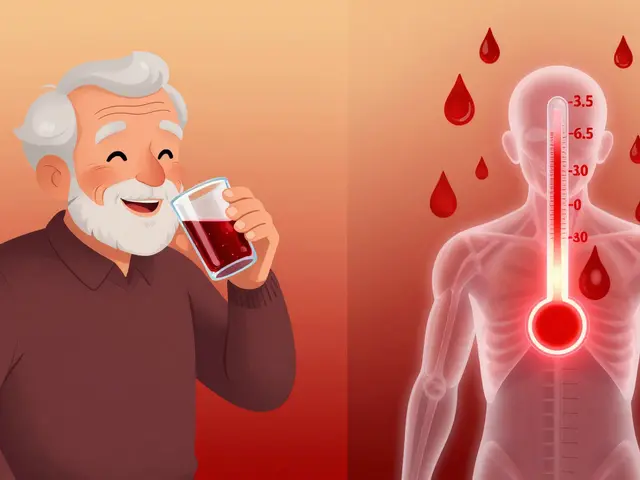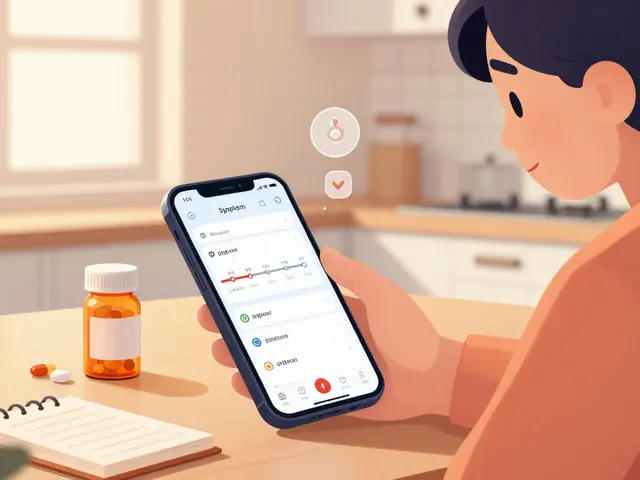The search for alternatives to Metformin, a cornerstone drug in the management of type 2 diabetes, offers a treasure trove of innovative treatments in 2025. As the face of healthcare evolves, so does our approach to treating chronic conditions like diabetes. For many, Metformin remains effective, but for others, whether due to side effects or personal preference, alternatives offer a suitable refuge.
This exploration of nine Metformin alternatives will illuminate their potential, delving deep into the intricate weave of science and practical application, making sense of what works best for each individual's lifestyle and health requirements. Whether you're hoping to switch for health concerns, or merely curious about what's new, this is your briefing on the emerging landscape of diabetes management.
- GLP-1 Receptor Agonists
- SGLT2 Inhibitors
- DPP-4 Inhibitors
- Thiazolidinediones
- Alpha-glucosidase Inhibitors
- Bile Acid Sequestrants
- Meglitinides
- Herbal and Nutritional Supplements
- Diet and Lifestyle Overhauls
GLP-1 Receptor Agonists
GLP-1 Receptor Agonists are among the promising alternatives to Metformin designed to tackle type 2 diabetes with a fresh approach. These medications mimic the glucagon-like peptide-1 (GLP-1) hormone, which plays a key role in glucose regulation and appetite control. Unlike some traditional treatments, they offer a twofold benefit of lowering blood sugar levels and aiding in weight loss, which is particularly beneficial for overweight individuals with diabetes.
How They Work
The mechanism of GLP-1 receptor agonists is fascinating. By activating the GLP-1 receptors, they stimulate insulin secretion only when glucose levels are high, which minimizes the risk of hypoglycemia, a common concern with several diabetes medications. They also slow gastric emptying, which helps to lower blood glucose spikes and enhances feelings of satiety, leading to potential weight loss.
Pros
- Effective blood sugar control: These agents can significantly reduce HbA1c levels, a key indicator of blood sugar control.
- Weight loss benefits: Many users experience beneficial weight reduction as a result of appetite suppression and prolonged satiety.
- Low risk of hypoglycemia: As these drugs enhance insulin secretion only when needed, they carry a lower risk of causing dangerously low blood sugar levels.
- Cardiovascular benefits: Some studies have shown that GLP-1 receptor agonists may reduce the risk of cardiovascular events, making them a preferred choice for patients with coexisting heart conditions.
Cons
- Gastrointestinal side effects: Nausea and vomiting are common initial side effects, though they usually decrease over time.
- Injection based: Unlike Metformin, which is usually taken in pill form, GLP-1 agonists are typically administered via injection, which might not be convenient for all patients.
- Cost: These medications can be expensive and may not always be covered by insurance, posing a financial burden for some users.
Market Approval and Variants
Several GLP-1 receptor agonists have gained approval and are widely used in medical practice today, including medications like semaglutide, liraglutide, and dulaglutide. Each of these comes with its own dosing regimen and side effect profile, allowing for personalized medicine tailored to individual patient needs.
| Medication Name | Dosing Frequency | Weight Loss Efficacy |
|---|---|---|
| Semaglutide | Weekly | High |
| Liraglutide | Daily | Moderate |
| Dulaglutide | Weekly | Moderate |
This extensive choice means that while the GLP-1 receptor agonists are not a one-size-fits-all solution, they offer a versatile option to those seeking Metformin alternatives in the dynamic world of diabetes care. Their proven efficacy, along with added benefits beyond diabetes control, positions them as a compelling option in modern therapeutic strategies.
SGLT2 Inhibitors
In the realm of diabetes treatment, SGLT2 inhibitors have emerged as a powerful contender, offering an innovative approach to glucose management. These inhibitors act by blocking the sodium-glucose co-transporter 2 (SGLT2) protein located in the kidney. By inhibiting this transporter, SGLT2 inhibitors prevent reabsorption of glucose into the blood, leading to excess glucose being excreted through urine.
How They Work
SGLT2 inhibitors work independently of insulin, which can be a significant advantage for those whose diabetes management strategies are not fully addressed by insulin-based treatment alone. This mechanism not only helps lower blood sugar levels but also has a beneficial effect on weight management and blood pressure, providing a comprehensive approach to tackling multiple facets of type 2 diabetes.
Pros
- Effective in decreasing blood sugar levels.
- Benefits beyond glucose control, such as weight loss and blood pressure reduction.
- Potential cardiovascular benefits as shown in several clinical trials.
- Convenient oral administration, typically once daily.
Cons
- Increased risk of urinary tract infections due to higher glucose concentrations in urine.
- Potential risk of ketoacidosis, especially in cases of low carbohydrate intake or illness.
- Higher cost compared to traditional treatments like Metformin.
SGLT2 inhibitors have been a topic of extensive research and interest in recent years. Two major clinical trials, the EMPA-REG OUTCOME and the CANVAS Program, have highlighted their cardiovascular benefits, revealing reduced risks of major adverse cardiovascular events. Such findings have sparked optimism among healthcare professionals who aim for a holistic approach to diabetes management.
While the benefits are compelling, healthcare providers must carefully weigh these against potential drawbacks, particularly the risk of infections and ketoacidosis. As always, individual treatment plans should be tailored to the specific needs and health profiles of patients, ensuring that the chosen strategy aligns with their overall health goals and preferences.
DPP-4 Inhibitors
Among the burgeoning alternatives to Metformin, DPP-4 inhibitors stand as a classic example of therapeutic advancement in diabetes treatment. Dipeptidyl peptidase-4 inhibitors work by blocking the DPP-4 enzyme, leading to increased levels of incretin hormones. These hormones play a pivotal role in regulating glucose homeostasis by enhancing the body's insulin response and may also inhibit glucagon release after meals, promoting a more balanced blood sugar level.
DPP-4 inhibitors, often prescribed to patients who have not achieved sufficient glycemic control through diet and exercise alone, come with an added bonus for those wary of medication-induced hypoglycemia—many within this class are associated with a lower risk of significantly lowering blood sugar levels compared to other treatments.
Pros
- Effective for Type 2 diabetes management, particularly after other methods have fallen short.
- Lower risk of hypoglycemia, offering a more stable and predictable glucose control.
- Usually well-tolerated with fewer gastrointestinal side effects than Metformin.
- May contribute to weight neutrality, making it favorable for patients concerned about weight gain.
Cons
- Sometimes less potent in reducing HbA1c compared to other classes of diabetes medications.
- Relatively high cost without insurance coverage, which can influence accessibility.
- Potential, albeit rare, side effects including upper respiratory infections, joint pain, or pancreatitis.
- Limited long-term data compared to Metformin, raising questions about their longevity and overall risk profile.
For a snapshot of the treatment landscape, a variety of DPP-4 inhibitors such as Sitagliptin, Saxagliptin, and Linagliptin prominently feature in therapeutic regimens, often combined with other diabetes medications to maximize effectiveness. Yet, as with any medication, consultation with a healthcare professional remains crucial to tailor diabetes treatment to individual risk profiles and health goals.
Thiazolidinediones
Thiazolidinediones, often abbreviated as TZDs, are a class of medications that have been carving a significant niche in the management of type 2 diabetes, serving as a notable alternative to Metformin. This group of drugs, which includes well-known names like pioglitazone and rosiglitazone, works by increasing the body's sensitivity to insulin. Essentially, they help the body use insulin more effectively—a critical function for individuals whose cells have become less responsive to the hormone.
Pros
- Improved Insulin Sensitivity: TZDs are particularly effective at enhancing insulin action in peripheral tissues, leading to improved blood sugar control.
- Versatility: These drugs are often used alongside other diabetes medications to improve glycemic control, offering flexibility in treatment.
- Cardiovascular Benefits: Pioglitazone, for instance, has shown some promise in reducing cardiovascular risks in certain patients.
Cons
- Weight Gain: One of the most frequently noted disadvantages is the potential for weight gain, which can be a concern for many patients with diabetes.
- Risk of Edema: Thiazolidinediones can cause fluid retention, potentially leading to edema and exacerbated heart failure in predisposed individuals.
- Bone Fracture Risk: Long-term use has been associated with an increased risk of fractures, particularly in women, due to changes in bone density.
While Thiazolidinediones offer substantial benefits, their profile demands a careful balancing act to ensure the advantages outweigh potential side effects. For many, these medications can provide improved diabetes control with mindful medical guidance and appropriate lifestyle adjustments. As with any medication change, it's crucial to consult healthcare providers to tailor treatments to personal health profiles.

Alpha-glucosidase Inhibitors
Alpha-glucosidase inhibitors, a class of oral medications used in the management of type 2 diabetes, offer a unique alternative to traditional treatment strategies like Metformin. These inhibitors work by delaying the absorption of carbohydrates in the small intestine, effectively blunting postprandial glucose spikes. They represent a particularly enticing option for individuals struggling with post-meal blood sugar management.
Pros
- Effective in reducing postprandial blood sugar levels, which is crucial for overall glycemic control.
- As they operate in the intestinal tract, these inhibitors have a favorable safety profile with minimal systemic absorption.
- Can be paired with other anti-diabetic medications, enhancing comprehensive diabetes management.
- They are free from the risks of hypoglycemia when used alone.
Cons
- Common gastrointestinal side effects, such as bloating and flatulence, which some patients may find bothersome.
- Less effective at lowering HbA1c levels compared to some other glucose-lowering medications.
- Requires three-times-daily dosing with meals, which can be inconvenient for some patients.
A notable example within this class is acarbose, which demonstrates effectiveness and safety across numerous studies. While not as potent as some newer agents, alpha-glucosidase inhibitors remain a valuable part of the diabetes toolkit, particularly for those who need to target postprandial glucose peaks.
According to a recent 2024 survey, approximately 15% of patients with type 2 diabetes reported using alpha-glucosidase inhibitors either alone or as part of their broader treatment regime. This highlights the role they continue to play in the landscape of diabetes treatment for those exploring alternatives to Metformin in 2025.
Bile Acid Sequestrants
In the quest for effective diabetes management options, Bile Acid Sequestrants have emerged as a unique alternative to Metformin, coupling lipid management with blood glucose control. These medications are traditionally used to lower cholesterol levels but have shown promise in addressing type 2 diabetes through their action on the digestive process.
By binding bile acids in the intestine, these sequestrants interrupt the enterohepatic circulation, forcing the liver to convert more cholesterol into bile acids. This process not only lowers cholesterol levels but also impacts glucose metabolism beneficially. Interestingly, they work independently of insulin, making them a versatile option for patients with specific needs.
Pros
- Dual benefit of controlling cholesterol and blood sugar.
- Minimal risk of hypoglycemia due to their non-insulin-dependent action.
- Can be combined with other diabetes medications for enhanced effect.
- Favorable for patients with both diabetes and dyslipidemia.
- Proven tolerance over long-term use with manageable side effects.
Cons
- Potentially significant gastrointestinal side effects, such as constipation or abdominal discomfort.
- May interfere with the absorption of other medications, requiring careful timing and management.
- Typically less potent in reducing glucose levels compared to other options.
- Not suitable for individuals with a history of bowel obstruction.
As the medical community continues to unpack the multifaceted mechanisms of Bile Acid Sequestrants, their dual-purpose nature presents a noteworthy option for those battling both high cholesterol and diabetes. While they may not replace Metformin entirely for every patient, they carve out an essential niche in the broader landscape of diabetes treatment in 2025.
Meglitinides
In the landscape of diabetes management, meglitinides have carved out a niche as a potent alternative to Metformin, especially for those who struggle with high blood sugar levels following meals. As a category of oral antidiabetic drugs, meglitinides operate by stimulating the pancreas to secrete more insulin, similar to sulfonylureas, yet with a shorter duration of action.
One of the key benefits of meglitinides is their ability to provide flexibility in diabetes management. These medications, such as Repaglinide and Nateglinide, can be adjusted according to the timing and content of meals, accommodating varied eating schedules without sacrificing blood sugar control.
Pros of Meglitinides
- Rapid onset of action, making them effective for postprandial glucose control.
- Flexibility in the timing of administration concurrent with meals.
- Lower risk of prolonged hypoglycemia compared to some other antidiabetic medications.
- Useful for patients who have high blood sugar spikes after meals.
Cons of Meglitinides
- Need for multiple daily doses, which can be cumbersome for some patients.
- Potential for weight gain due to increased insulin levels.
- Possible interactions with other medications affecting the liver's enzyme pathways.
- May not be as effective in maintaining overall blood glucose control compared to sustained-release alternatives.
Usage and Considerations
Meglitinides are often prescribed to patients who do not tolerate Metformin well or in conjunction with other medications when Metformin alone is insufficient. However, they require careful monitoring by healthcare providers to minimize hypoglycemic risks. Patients are advised to match their intake of these drugs closely with meals to optimize their effectiveness and reduce side effects.
As 2025 unfolds, the role of meglitinides in diabetes management continues to be one of adaptability and precision. For many patients, these medications offer a viable path that aligns closely with their lifestyle, dietary habits, and therapeutic goals.
Herbal and Nutritional Supplements
The world of natural remedies has opened its arms wide to fight diabetes, offering numerous options that provide gentler alternatives to Metformin. With a plethora of herbal and nutritional supplements now available, individuals struggling with diabetes can explore treatments that align more closely with personal and dietary preferences.
Berberine: Nature's Metformin
Berberine, a compound extracted from various plants including the goldenseal and barberry, mirrors many of Metformin's glucose-regulating effects. It has been extensively studied and shown to significantly lower blood sugar levels. Unlike its pharmaceutical counterpart, berberine may also support heart health and reduce cholesterol levels.
Cinnamon: The Sweet Supplement
Cinnamon isn't just a spice that makes your toast tastier; it also comes with a hidden benefit for diabetes management. Some studies suggest that cinnamon can enhance insulin sensitivity, making it a favorite among those looking to lower their blood sugar naturally. While the effects are generally moderate, the ease of including cinnamon in the diet makes it an appealing option.
Chromium: The Mineral Helper
This trace mineral plays a vital role in the metabolism of carbohydrates and fats. When supplemented appropriately, chromium may improve the body's response to insulin, potentially helping to manage type 2 diabetes. It's crucial, however, to use it under medical guidance to avoid imbalances.
The Promise of Probiotics
Emerging data also suggests that probiotics, those friendly bacteria residing in our gut, might have a part to play in managing diabetes. By improving gut health, probiotics might indirectly affect glucose regulation and insulin sensitivity. A healthy gut often leads to unexpected but powerful improvements in blood sugar control.
Pros
- Natural compounds often come with fewer side effects than pharmaceuticals.
- Many supplements are easy to integrate into daily routines.
- They often provide additional health benefits beyond glucose control.
Cons
- Effectiveness can be less predictable compared to standard medications.
- Quality and potency can vary widely between products.
- Self-regulation can lead to potential under or over-dosing without professional guidance.
With the 2025 healthcare landscape embracing personalized medicine more than ever, herbal and nutritional supplements stand as a testament to nature's potential in aiding diabetes treatment. While they are no panacea, when used thoughtfully, these supplements can complement traditional therapies, providing a holistic approach to diabetes management.

Diet and Lifestyle Overhauls
In 2025, the conversation around managing diabetes frequently shifts toward holistic approaches, underscoring the importance of diet and lifestyle overhauls. While medication, like Metformin alternatives, play a critical role, adopting sustainable lifestyle changes can significantly enhance treatment outcomes.
Why It Matters
Research has consistently shown that diet and lifestyle choices can either mitigate or exacerbate the effects of type 2 diabetes. In fact, according to the American Diabetes Association, a combination of regular physical activity and improved nutrition can reduce A1C levels by up to two percent, which is roughly on par with some diabetes medications.
Dietary Guidelines
Optimizing one's diet involves more than just cutting out sugar. A comprehensive dietary change emphasizes the intake of whole foods, lean proteins, and a variety of colorful vegetables and fruits. Here are some recommendations:
- Adopt a low-glycemic index diet to prevent blood sugar spikes.
- Incorporate healthy fats, such as those found in avocados, nuts, and olive oil.
- Focus on portion control and regular meals to maintain consistent blood glucose levels.
Success Story: The Mediterranean Diet
The Mediterranean diet has emerged as a front-runner in diabetes management. With its emphasis on plant-based foods, whole grains, and healthy fats, it has been linked to reduced risk of cardiovascular diseases and decreased inflammation.
"The Mediterranean diet is not just a diet; it's a lifestyle. Studies have shown it can lower the risk of heart disease and diabetes while also improving cognitive function," says Dr. Philip Eaton, a renowned endocrinologist.
Incorporating Physical Activity
Exercise is another pillar of managing diabetes without solely relying on medication. Regular physical activity can help maintain a healthy weight, improve insulin sensitivity, and reduce the risk of complications. The American College of Sports Medicine recommends at least 150 minutes of moderate aerobic activity per week.
A balance of aerobic exercises, like walking or cycling, combined with resistance training can offer comprehensive benefits for individuals with type 2 diabetes.
Mindful Living
Stress management and adequate sleep reinforce the benefits of diet and exercise. Practices such as yoga, meditation, and mindfulness can help maintain mental health, which can significantly impact physical health. Fostering a balanced lifestyle ensures better compliance with dietary and physical activity recommendations.
Embracing diet and lifestyle overhauls represents more than just a temporary fix—it's a commitment to lifelong health, often reducing dependence on medications and enhancing overall wellness.
| Component | Recommended Daily Intake |
|---|---|
| Fiber | 25-30 grams |
| Protein | 1-1.5 grams per kg of body weight |
| Healthy Fats | 20-35% of total daily calories |




Wilson Roberto on 31 January 2025, AT 05:16 AM
When we contemplate the evolution of diabetes therapy, it becomes clear that each alternative to Metformin reflects a deeper understanding of human metabolism.
GLP‑1 agonists, for instance, illustrate how mimicking natural hormones can harmonize glucose control with weight management.
Similarly, SGLT2 inhibitors reveal the ingenuity of targeting renal glucose reabsorption, turning excess sugar into a harmless excretion pathway.
The rise of DPP‑4 inhibitors underscores the importance of preserving incretin activity, a subtle yet powerful mechanism.
Even older classes like thiazolidinediones remind us that enhancing insulin sensitivity remains a cornerstone of treatment.
Alpha‑glucosidase inhibitors, though modest, teach us that slowing carbohydrate absorption can blunt post‑prandial spikes.
Bile acid sequestrants demonstrate the interplay between lipid and glucose homeostasis, an often overlooked synergy.
Meglitinides, with their rapid onset, provide a flexible tool for post‑meal glucose spikes, catering to varied lifestyles.
Herbal supplements such as berberine and cinnamon bring centuries of ethnopharmacology into modern practice, offering complementary pathways.
Finally, the most profound alternative may be the comprehensive lifestyle overhaul that integrates diet, exercise, and stress management.
Each of these options, when viewed through a philosophical lens, represents a facet of the larger quest for personalized medicine.
Patients must weigh efficacy, safety, cost, and personal preference, recognizing that the “best” drug is often a tapestry of choices.
Clinicians, therefore, serve as guides, helping individuals navigate this mosaic with clarity and empathy.
In 2025, the convergence of these therapies promises not only better glycemic outcomes but also enhanced quality of life.
Thus, the journey beyond Metformin is less about abandonment and more about expansion, embracing a richer therapeutic horizon.